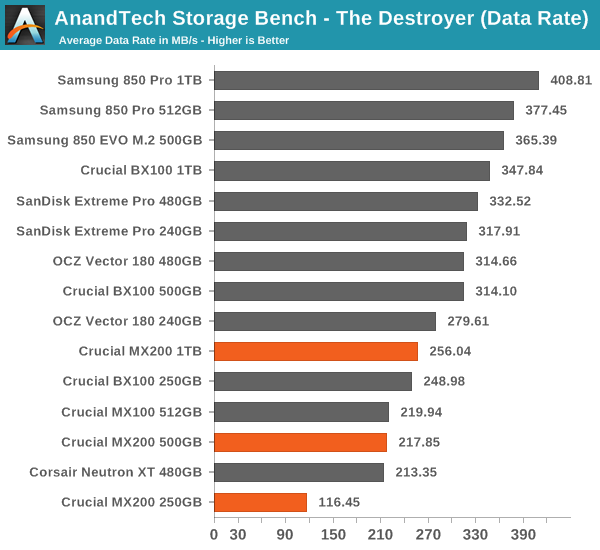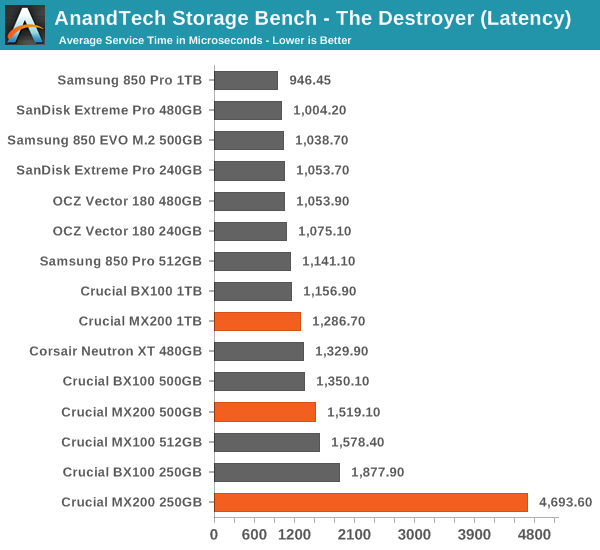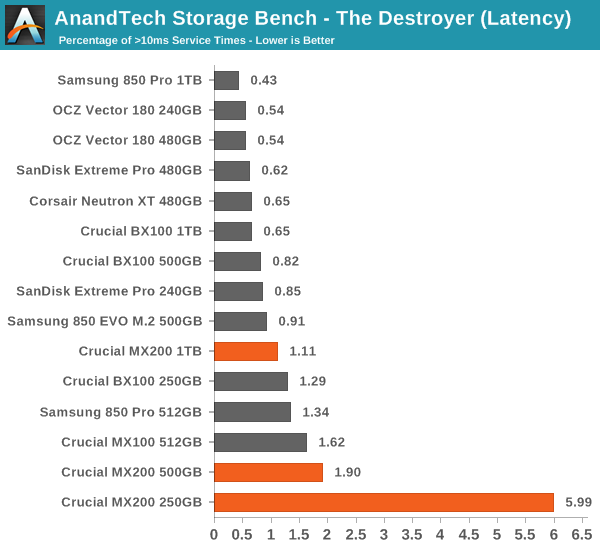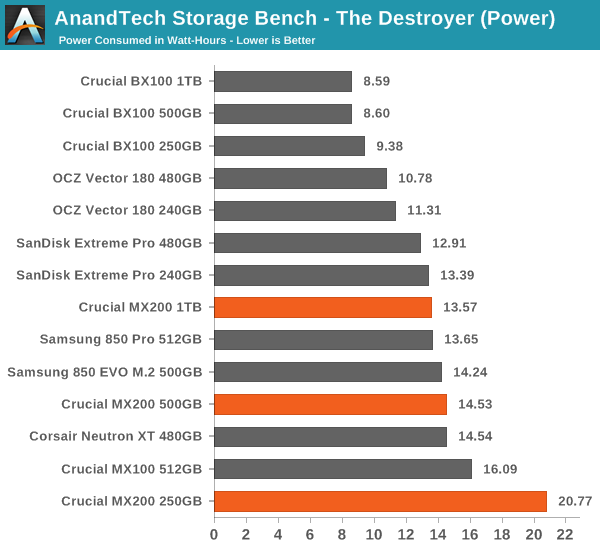Crucial MX200 (250GB, 500GB & 1TB) SSD Review
by Kristian Vättö on May 22, 2015 8:00 AM EST- Posted in
- Storage
- SSDs
- Crucial
- MX200
- Micron 16nm
AnandTech Storage Bench - The Destroyer
The Destroyer has been an essential part of our SSD test suite for nearly two years now. It was crafted to provide a benchmark for very IO intensive workloads, which is where you most often notice the difference between drives. It's not necessarily the most relevant test to an average user, but for anyone with a heavier IO workload The Destroyer should do a good job at characterizing performance. For full details of this test, please refer to this article.

Despite the improved IO consistency, the MX200 doesn't have any advantage over the MX100 in our heaviest The Destroyer trace. The MX200 is clearly not crafted for intensive IO workloads because there are far better drives available, which is a shame because I've been waiting for Crucial to deliver a true high-end drive, but the MX200 clearly isn't that. What's alarming is the fact that the BX100 is actually faster than the MX200, which doesn't speak too highly of Crucial-Micron's custom firmware for the Marvell controller.

Average latency doesn't really change the story as the MX200 is still a relatively slow drive by today's high-end SSD standards. Especially the performance of the 250GB is surprisingly bad and it looks like Crucial's SLC cache implementation isn't optimal for intensive IO workloads.

The share of high latency IOs is also pretty bad, although fortunately even the 250GB model manages to keep +100ms IOs within a reasonable limit.

The power consumption is quite average, but the BX100 is without a doubt far more power efficient even for high intensity IO workloads despite its position as a value drive.











62 Comments
View All Comments
KAlmquist - Saturday, May 23, 2015 - link
I'm hoping that once other companies get 3D NAND into production we will see some interesting competition for Samsung.austinsguitar - Friday, May 22, 2015 - link
I love how they post this but not the mx100 tests.... whats the FKING POINT in testing than?Ryan Smith - Friday, May 22, 2015 - link
I'm not sure I follow. The MX100 is in our graphs.earl colby pottinger - Friday, May 22, 2015 - link
Question about the hardware encryption.Where does the key come from? Can I set my own key?
The reason I ask is, if all the drives have the same key from the manufacturer then it is like there is no key at all. As if you know one key you know them all.
If it is made by a random number generator, how do we not know there is a pattern from the generator so a hacker only needs to do a few thousand (million?) tests to break the encryption?
If on the other-hand we can set the key, is it easy to do? Is the key such that we can write it to the drive but it is hard to read out?
Vinchent - Friday, May 22, 2015 - link
Wow I just purchased the MX200 250GB a couple of days ago.If I had read this article before, I wouldn't have bought it.
btw, thanks for this great article, AT :)
RandUser - Saturday, May 23, 2015 - link
Lol, same for me here. Should have gotten a BX100. The MX200 performs without problems though, so no point returning it, just it's not the best value for money.MrSpadge - Saturday, May 23, 2015 - link
If you don't fill it in a sudden rush, it's still a fine drive. Not the best choice, but not terrible either.PaulBags - Friday, May 22, 2015 - link
The Samsung 850 pro 1tb is missing from most charts, disappointing.Sejong - Friday, May 22, 2015 - link
No comments on the NAND being 16nm? Is this not an issue? I am reluctant to buy MX100, 200 and BX100 when there is M500 still in stock (the price seems to be rising).Another review request : Intel`s new SSD 535 (this seems to use hynix 16nm NAND memory).
MrSpadge - Saturday, May 23, 2015 - link
No, it's not an issue. Even with "just" the guaranteed endurance it's going to last a long time. And very probably a lot longer, as in any SSD which is not under continous sustained use (which would cause very high write amplification).